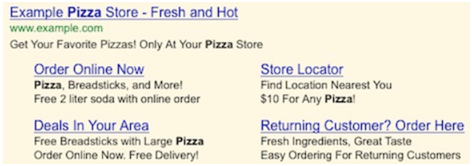Sitelinks
Spoiler Alert– This post is about advanced Pay-Per-Click stuff, so if you just can’t bear to think about PPC, skip to a different post. (You’ll miss some good tips about a profitable way to get new cases, though.)
Ever wonder why some ads on the search results pages are a lot bigger than the others, and contain a number of additional links?
The additional links are called “Sitelinks.” They’ve been around for a while, and they look like this:
The four links in the two bottom lines are links the advertiser sets up to specific pages in addition to the main landing page.
These “Sitelinks” do a couple of things: they take up more real estate on the page, making the ad more noticeable and more likely to get clicked, and they’re a shortcut to an exactly appropriate page, according to the searcher’s or customer’s interest.
This doesn’t just work for Pizza Parlors.
In addition to the ideas demonstrated in the above ad, Sitelinks can link directly to a page about a particular procedure, or your “About Us” page, or your “Testimonials” page, or your “As Seen On” page, or any other page. It’s worth noting that Google will determine which of your Sitelinks it will show. It may even choose to show a link to a different page than you set up, if its algorithm determines that that would be a better fit, based on the search.
Google says that ads with Sitelinks get an average of 30% more clicks than those without. Some other studies seem to indicate that it’s more like 10%-20%. Whatever the actual number, setting sitelinks so you can be more visible on the page, and get 10-30% more clicks for free has to be a good thing, right?
It’s a lot more complicated than that, of course. Isn’t everything? Shameless plug: That’s why you need a pro.
Some have said that it’s possible that the clicks attracted by your Sitelinks ad might have come to you for free if the searcher had clicked on your organic listing instead of your ad. That seems like over-thinking it to us, because more clicks and a higher CTR should improve your Quality Score, and lower your click costs so that your website advertising is more cost-effective.
That’s why you test, of course, to see how your actual cost per conversion (not per visitor) is affected. If you didn’t see our recent post on split testing, I think you’ll find it interesting.
Enhanced Sitelinks
If your existing ad is showing above the search results, with two or three lines of Sitelinks, and if you have other ads showing that contain information similar to your Sitelinks, Google will sometimes add some of that information to your Sitelinks to create “Enhanced Sitelinks.” That’s a little confusing, so here’s how it looks:
Here’s your ad, just like I showed above:
Now, if you also have these ads in your account:
Google may modify your original ad to look like this:
Hence the name. Your original Sitelinks are “Enhanced” with additional information you make available. Look how much “real estate” you get on the page!
Sitelinks or Enhanced Sitelinks don’t cost extra. A click on either kind costs you the same as a click on the primary URL, and if someone clicks on more than one link, you’ll only get charged for one click.
Bottom line? Sitelinks are potentially a huge benefit, but like anything else in this crazy Internet world, you need to test.
So . . . two thoughts:
- If you’re not doing Pay-Per-Click, you probably should be, so you can get more qualified visitors and more cases, with a very nice return on your investment
- If you’re doing Pay-Per-Click, or thinking about it, talk to us or somebody like us, so you do it smartly and get a very nice return on your investment.
With Google’s recent moves that seem designed to increase the number of paid ads, at the expense of the organic search listings, you may want to consider, or re-consider, or get started with a pay-per-click campaign. Sure there have been some horror stories about PPC marketing, mostly way overblown, but the truth is that a well-designed pay-per-click campaign can almost always get you visitors and business at a very attractive cost that leads to a very positive return on investment. Advertising on Google can pay big dividends.
PPC management is no longer something for amateurs. We’re bona fide Google AdWords experts. We can help.
Andrey




